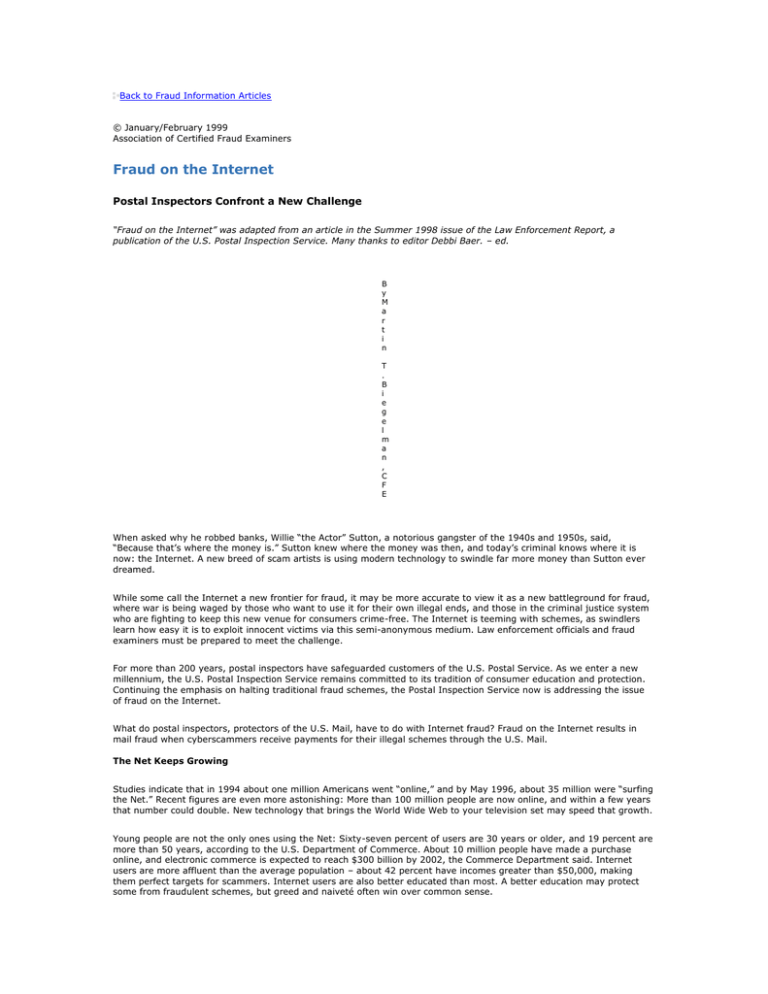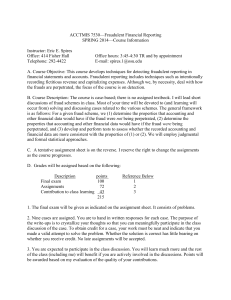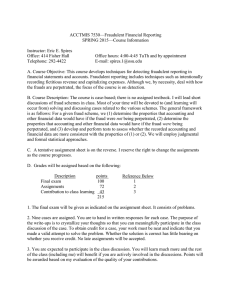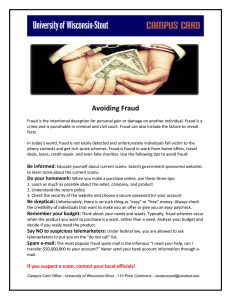Fraud on the Internet Postal Inspectors Confront a New Challenge
advertisement

Back to Fraud Information Articles © January/February 1999 Association of Certified Fraud Examiners Fraud on the Internet Postal Inspectors Confront a New Challenge “Fraud on the Internet” was adapted from an article in the Summer 1998 issue of the Law Enforcement Report, a publication of the U.S. Postal Inspection Service. Many thanks to editor Debbi Baer. – ed. B y M a r t i n T . B i e g e l m a n , C F E When asked why he robbed banks, Willie “the Actor” Sutton, a notorious gangster of the 1940s and 1950s, said, “Because that’s where the money is.” Sutton knew where the money was then, and today’s criminal knows where it is now: the Internet. A new breed of scam artists is using modern technology to swindle far more money than Sutton ever dreamed. While some call the Internet a new frontier for fraud, it may be more accurate to view it as a new battleground for fraud, where war is being waged by those who want to use it for their own illegal ends, and those in the criminal justice system who are fighting to keep this new venue for consumers crime-free. The Internet is teeming with schemes, as swindlers learn how easy it is to exploit innocent victims via this semi-anonymous medium. Law enforcement officials and fraud examiners must be prepared to meet the challenge. For more than 200 years, postal inspectors have safeguarded customers of the U.S. Postal Service. As we enter a new millennium, the U.S. Postal Inspection Service remains committed to its tradition of consumer education and protection. Continuing the emphasis on halting traditional fraud schemes, the Postal Inspection Service now is addressing the issue of fraud on the Internet. What do postal inspectors, protectors of the U.S. Mail, have to do with Internet fraud? Fraud on the Internet results in mail fraud when cyberscammers receive payments for their illegal schemes through the U.S. Mail. The Net Keeps Growing Studies indicate that in 1994 about one million Americans went “online,” and by May 1996, about 35 million were “surfing the Net.” Recent figures are even more astonishing: More than 100 million people are now online, and within a few years that number could double. New technology that brings the World Wide Web to your television set may speed that growth. Young people are not the only ones using the Net: Sixty-seven percent of users are 30 years or older, and 19 percent are more than 50 years, according to the U.S. Department of Commerce. About 10 million people have made a purchase online, and electronic commerce is expected to reach $300 billion by 2002, the Commerce Department said. Internet users are more affluent than the average population – about 42 percent have incomes greater than $50,000, making them perfect targets for scammers. Internet users are also better educated than most. A better education may protect some from fraudulent schemes, but greed and naiveté often win over common sense. Since the Internet’s birth in 1969, it has been invaded by criminals. Computer hackers have gained unauthorized access to computer systems and wreaked havoc by stealing information, corrupting files, and introducing viruses. Now it is the con artist’s turn. It is easy to see the potential for conducting fraud via the Internet. Crimes that have long depended on the U.S. Mail, such as investment schemes, get-rich-quick scams, and credit card frauds are now online as well. The National Fraud Information Center reports that the top 10 Internet scams of 1997 were online auctions, bogus services, fraudulent merchandise offers, misrepresented computer sales, pyramid schemes, bogus business opportunities, work-at-home schemes, advance credit card scams, illegal sweepstakes or prizes, and fraudulent book sales or subscriptions. The National Consumers League, which operates the site, now receives 500 e-mails a day with questions about possibly fraudulent or deceptive Web sites. According to the league, in 1997, more than half of all Internet fraud it tracked was paid for through the U.S. Mail using a check or money order, and an additional 22 percent was paid by credit card. Internet Outlaws Today’s Internet scams are just extrapolations from earlier computer frauds made possible with more sophisticated technology. Déjà vu all over again. In 1985, postal inspectors discovered teenagers in Long Island, N.Y., involved in credit card fraud after they found a primer describing the scam’s procedures on a computer bulletin board. The teens obtained unauthorized credit card numbers from other computer sites and by “dumpster diving” in garbage bins, as explained in the online manual. Before they were caught, the teens ordered thousands of dollars of computer equipment and had the merchandise mailed to a nearby home while the occupants were on vacation. In April 1997 in Los Angeles, Calif., five teenagers were arrested for essentially the same scheme. They used their computer expertise to acquire credit card numbers and other information from subscribers to an online service, and then purchased merchandise through the Internet with the stolen numbers. The teens had the merchandise delivered to a vacant house in the neighborhood. A search of the teens’ homes found the illegally obtained merchandise, lists of stolen credit card numbers and personal information, invoices, computer equipment, and orders from other high school students who wanted a share in the fraud. Web sites advertising “Credit Card Fraud Technique” and “Credit Card Fraud Made Easy” are there for the interested, although they warn against using the information. One disclaimer states, “All readers should be aware that actually attempting to use the information described below will certainly lead to arrest and imprisonment,” and another advises, “It is illegal, and therefore I do not participate in it, neither should you.” Unfortunately, Internet outlaws do not take heed. Chain Letters and Work-at-Home Scams Chain letters are illegal, whether sent by mail or the Internet, but thousands of scams are online using basically the same letters that are sent through the mail, with similar misrepresentations and false promises: “Read me, you won’t be sorry!!!” “Fast cash, no jokes, important, must download!!!!!” “$$$Make $50,000 Fast$$$” “Honest Money” “How to Get Rich Quick” “!!!Quit Your Job Now!!!” Each letter attempts to outdo the other with guarantees of legality and honesty. One promised, “I swear I’m not lying to you and this is not a scam!” Another stated, “Make sure you include the note: Please add me to your mailing list. This makes it legal, as in this way you are paying for a legitimate service and it cannot be considered a chain letter.” The most prophetic chain letter I found on the Internet may be this one: “There are millions of Internet users, and millions of new net surfers every month! This is the great plus of the Internet, people all over the world can hear you and will listen carefully if you talk reasonably. Everyone will take that chance! I agree, if it wasn’t the Internet, and was a small circle of people, the chance wouldn’t have been so small. … But here, on the Internet, it is a giant village, where thousands of new members join every day! You can’t lose!!!” Securities and Investment Fraud For years, postal inspectors have investigated securities and investment schemes conducted through the mail. Inspectors in New York aggressively attacked insider trading and stock fraud, resulting in the convictions of Wall Street legends Ivan Boesky, Michael Milken, and numerous others involved in multimillion-dollar investment schemes. Investment and stock fraud schemes are proliferating on the Internet, and the U.S. Postal Inspection Service must attack these problems to protect consumers. Scam artists find the Internet to be the perfect device for cheating the greedy and the gullible. For example, investors are defrauded by “pump and dump” schemes, in which stock promoters buy little-known and generally worthless stocks and promote them on the Internet with lies and misrepresentations. The operators claim insider knowledge, scientific breakthroughs, and amazing investor opportunities. Once unsuspecting victims buy these “pumped up” stocks, they find that the promoters have “cashed in” their shares and the now worthless stocks have been “dumped” on them. Internet fraudsters falsely promise exciting, low-risk, high-return investment opportunities in an endless series of wireless cable projects, eel farms, coconut plantations, ATM ventures, and other bogus offerings. Although enforcement is increasing, the problem continues to grow. Stock fraud is likely to continue because of the huge sums of money that can be made and because of investors’ naiveté. Close monitoring of the Internet, along with aggressive enforcement and heightened public awareness, is needed drastically in this area. Mail-in Rebate Fraud To encourage consumers to purchase their products, many manufacturers offer rebates to their customers, generally in the form of cash. Rebate fraud costs consumers and manufacturers more than $500 million each year. This type of fraud occurs when a person submits a rebate claim for a product he did not purchase along with a counterfeit, stolen, or fraudulently obtained proof of purchase, and a phony cash register receipt. The coupon industry tries to prevent fraud by requiring a “complete deal” for legitimate rebates: You must submit all the items listed on the rebate form – usually the form itself, the Universal Product Code (UPC) from the product package, and the cash register receipt – so the manufacturer knows you purchased the product and have met the terms and conditions of the offer. However, the Internet makes rebate fraud easier. Even though legitimate manufacturers have Web sites that advertise and promote their products through rebates and cents-off coupons, hundreds of scammers also post rebate and cents-off coupons, many of which appear to be counterfeit. One Web site offers UPCs for dozens of food, grooming, and household products, among others. Another advertises “complete deals” for dozens of popular products. Still other sites feature rebate coupons and counterfeit receipts to be used for fraudulent rebates. In one instance, postal inspectors obtained a federal court order to break up a large rebate ring run by four women in Houston, Texas. In addition to using 68 addresses in 12 surrounding towns, the group counterfeited cash register tapes they had created on home computers. One individual said she was earning nearly $1,000 a week from her fraudulent activity. Another case involved an Atlanta, Ga., woman whom postal inspectors found was running a rebate scam on numerous manufacturers using a variety of schemes. The defendant received a prison sentence, and the federal government seized her assets, including her home. Total losses to manufacturers were estimated at nearly $500,000. In 1995, the U.S. Postal Inspection Service formed the Rebate Fraud Task Force, joining with industry members to reduce this pervasive crime. The task force developed internal controls to safeguard mail-in offers and address the problem of dishonest rebaters not only through the mail but on the Internet. Inspectors and industry representatives have identified suspect rebaters online and used undercover identities to expose their schemes, resulting in criminal and civil actions. The number of fraudulent rebate sites, consequently, is decreasing. Mail-order Fraud Scam artists are moving quickly to this new venue. Older mail fraud schemes – such as customers ordering merchandise and then failing to pay for it, or companies collecting money for merchandise that is never sent – are flourishing on the Internet. Fraudsters set up a Web site, offer items at attractive prices, receive payments, and fail to ship the items or make refunds. They then close up shop and start the whole process over with a new name and Web site. In one recent case, someone posted Web sites advertising computer hardware and software for sale, but never delivered any merchandise to customers. Postal inspectors broke the case after discovering the perpetrator was on probation for other crimes. Under the Mail Order Initiative, the U.S. Postal Inspection Service has formed a partnership with the direct marketing industry to combat losses resulting from mail fraud schemes and the non-receipt of merchandise. In a pilot program, the task force already has reduced non-receipt losses by 10 percent to 15 percent for direct marketing companies experiencing mail-processing problems. Prompt identification and criminal investigation of mail theft and fraud promises to reduce losses further. The task force also is working with companies to create an industry-wide database to maintain fraud statistics and more quickly identify perpetrators. The Future is Bright -- but Don’t Wear Shades Educated consumers have learned to be wary of door-to-door salespeople who try to sell them the moon. Postal inspectors have taught consumers to be equally suspicious of telephone or mail-in offers that are “too good to be true.” Now inspectors need to enlighten the American public about the potential for fraud on the Internet. As the Internet grows, more Web users will be victimized by modern-day versions of Willie Sutton. The U.S. Postal Inspection Service is committed to putting these Internet outlaws behind bars and educating consumers on how to avoid fraudulent scams. The same rules of common sense and caution apply when conducting transactions online. Don’t forget: “If it sounds too good to be true – even if it is on the Internet – it probably is!” Martin T. Biegelman, CFE, is inspector in charge of the Phoenix (Arizona) Field Office of the Postal Inspection Service. SIDEBAR U.S. Postal Inspection Service Tackles Internet Fraud The U.S. Postal Inspection Service maintains a home page on the World Wide Web. The site contains information on the history and mission of the inspection service, descriptions of consumer and business fraud schemes and consumer alerts about current scams such as fraud against the elderly. Visit the site at www.usps.gov/postalinspectors. The inspection service’s Mail Fraud Complaint Form is available at fraud@uspis.gov. The completed form can be mailed with necessary attachments to one of the inspection service offices. The Postal Inspection Service’s Internet Fraud Subgroup, part of the Consumer Fraud Working Group, identifies fraud on the Web and works with other agencies to protect consumers. A new bill, unanimously passed by both the Senate and the House of Representatives, was signed into law by President Clinton on Oct. 30, 1998. The bill establishes fines and increases penalties for anyone using the mail or Internet for child sex offenses. Postal inspectors and agents from the Federal Trade Commission (FTC), as well as other federal and state investigators, have been surfing the Net to identify illegal business opportunities, pyramid schemes, lotteries, and chain letters. Dubbed “Surf Days,” the investigators use this time to search Web sites, newsgroups, and online postings to identify fraudulent activity. FTC agents send e-mail warnings to potentially fraudulent operators and explain how various schemes are illegal. As a result, numerous suspect sites either have voluntarily closed down or altered their promotions. The inspection service believes that using partnerships to combat fraud is the most effective way of protecting the public. SIDEBAR SEC Accuses 44 Promoters of Internet ‘Pump-and-Dump’ Stock Fraud The Securities and Exchange Commission (SEC) in October 1998, accused 44 stock promoters, Web site operators, and newsletter publishers of fraudulently promoting small-company stocks over the Internet. In its first major Internet crackdown, the SEC alleged that the companies and individuals violated federal securities laws by misrepresenting the prospects of more than 235 small firms and not fully disclosing that they were being paid by the firms to tout their low-priced stocks over the Internet, the classic “pump-and-dump” scam. False information was communicated through junk electronic mail known as “spam,” online newsletters, message-board postings, and Web sites, the SEC said. The accused Internet companies purported to provide unbiased opinions in their recommendations but did not mention that they had received more than $6.3 million and nearly two million shares of cheap insider stock and options in exchange for touting services. In some instances, the fraudsters practiced “scalping” – selling their stock or exercising their options following their recommendations. “In all these cases,” said Richard H. Walker, the SEC’s director of enforcement, “the Internet promoters gave ostensibly independent opinions about microcap companies that in reality were bought and paid for. Not only did they lie about their own independence, some of them lied about the companies they featured, then took advantage of any quick spike in price to sell their shares for a fast and easy profit.” In one case, an Internet newsletter recommended to its more than 100,000 subscribers the purchase of approximately 25 microcap stocks predicted to double or triple in the months following dissemination of the recommendations. However, the company failed to disclose that it had received $1.6 million of compensation in cash and stock from the profiled issuers. The investigations show that illegal stock promoters are changing their advertising medium. A southern California promoter moved his claims from newspaper ads to his new Web site without disclosing that microcap issuers had paid for the recommendations. The SEC’s new Office of Internet Enforcement, according to Walker, wants to send the message that the SEC is watching. Source: The Securities and Exchange Commission The Association of Certified Fraud Examiners assumes sole copyright of any article published in Fraud Magazine. Fraud Magazine follows a policy of exclusive publication. Permission of the publisher is required before an article can be copied or reproduced. Requests for reprinting an article in any form must be e-mailed to: FraudMagazine@ACFE.com.



